Servicios Personalizados
Revista
Articulo
Indicadores
-
 Citado por SciELO
Citado por SciELO
Links relacionados
-
 Similares en
SciELO
Similares en
SciELO  uBio
uBio
Compartir
Multequina
versión On-line ISSN 1852-7329
Multequina vol.23 no.1 Mendoza 2014
ARTICULO ORIGINAL
Reserve paddock as an agroforestry technique in the arid lands of Mendoza, Argentina
El potrero de reserva como técnica agroforestal en la zona árida de Mendoza, Argentina
Eduardo Martínez Carretero y Antonio Dalmasso
Geobotany and Fitogeography, Instituto Argentino de Investigaciones de las Zonas Aridas (IADIZA), CC 507, 5500 Mendoza - Argentina mcarrete@mendoza-conicet.gob.ar
Summary
In the arid lands in the northeast of Mendoza province (Argentina) the only possible subsistence economy is extensive livestock breeding. Mean plant cover in the area is 45%. Natural vegetation is dominated by open forests of Prosopis flexuosa DC associated with a shrub layer of Atriplex lampa Gill. ex Moq. The present carrying capacity ranges between 7.5 and 2.12 ha per animal unit, at sites in poor and good conditions respectively. The only alternative agroforestry technique in this region is selecting areas as reserve paddocks and enriching them with native fodder species. A total yield of 489.5 kgDM/ha/year could be reached in these areas by combining plant species such as A. lampa, Tricomaria usillo Gill. ex H. et A., Lycium chilense Miers ex Bert., and Prosopidastrum globosum (Gill. ex Hook. et Arn.) Burk. with P. flexuosa. Such association would allow for a carrying capacity of 0.8 ha per animal unit. Reserve paddocks ensure a richin- protein forage supply in critical periods (November-January). Their management involves two-hour grazing a day, alternating natural range with the reserve paddock. Reserve paddocks allow increased offer of marketable kids from the same herd of mother goats, since the latter obtain better nourishment without exerting additional grazing pressure.
Key words: Fodder species; Forest; Goats; Management; Prosopis; Reserve paddock
Resumen
En la zona árida del nordeste de Mendoza (Argentina) la única economía posible es la de subsistencia a través de la ganadería extensiva. La cobertura vegetal media en el área es del 45%. La vegetación natural es dominada por un bosque abierto de Prosopis flexuosa DC asociado a un estrato arbustivo con Atriplex lampa Gill. ex Moq. La capacidad de carga actual varía entre 7,5 y 2,12 ha/animal, en sitios de pobre y buena condición respectivamente. La única técnica agroforestal posible es la de selección de áreas como potreros de reserva y su enriquecimiento con especies nativas forrajeras. Un total de 489,5 kgMS/ha/año podría alcanzarse in estas áreas mediante la combinación de especies como A. lampa, Tricomaria usillo Gill. ex H. et A., Lycium chilense Miers ex Bert. y Prosopidastrum globosum (Gill. ex Hook. et Arn.) Burk. con P. flexuosa. Esta asociación permitiría una capacidad de carga de 0,8 ha por unidad animal. El potrero de reserva accordasegura un suplemento forrajero rico en proteína en los períodos críticos (noviembre-enero). Su manejo involucra dos horas diarias de pastoreo, alternando con la vegetación natural. El potrero de reserva permite incrementar la oferta de crías al mercado, al lograr las madres mejor nutrición.
Palabras clave: Especies forrajeras; Bosque; Cabras; Manejo; Prosopis; Potrero de reserva
Introduction
The eastern plains of Mendoza extend over approximately 56,000 km2. These plains are constituted by alluvial material, showing water and aeolian erosion. Sand dune systems are Holocenic (Masotta& Berra, 1994). Elevation ranges between 450 and 750 m, and average annual precipitation between 110 and 250 mm (Table 1).
Table 1. Precipitation and temperature records in the East of Mendoza: Meteorological stations Encón (1971-78) (Estrella et al., 1979) and El Divisadero (1941-60, 1972-78) (Méndez et al., 1993) and (1986-1995) (Guevara et al., 1997)
Tabla 1. Registros de precipitación y temperatura en el este de Mendoza: Estación Meteorológica Encon (1971-1978) (Estrella et al., 1979) y El Divisadero (1941-60, 1972-78) (Méndez et al., 1993) y (1986.1995) (Guevara et al., 1997)
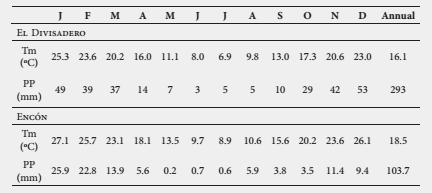
Aridity increases northwards, reaching hyperarid conditions in the northeastern most localities (Roig et al., 1988). The scarce monthly precipitation and high monthly evapotranspiration—80 mm in July and 193 mm in January (Berra & Ciancaglini, 1979)—determine an annual hydric deficit of 1,312.5 mm in the entire area (Méndez et al., 1993).
The plains lie on sloping sandy and sandy-loamy soils with dunes up to 20 m high to the north. The landscape is dominated by three units: sand dunes, interdune depressions, and saline flat lands. In interdune depressions soils are mainly deep and sandy, showing 6.4 < pH < 7.6; 0.09 < OM < 0.22%; 360 < N < 420 ppm and 0.170 < EC < 0.38 μScm-1 (Masotta & Berra, 1994). Most soils are Entisols (Psamment and Torripsament), according to the American classification. A water table is present throughout the area, its hydrostatic depth varying from 30 to 78 m (Tanquilevich, 1971).
The dominant vegetation consists of perennial shrub species, particularly Larrea divaricata and Bulnesia retama (Zygophyllaceae), accompanied by Capparis atamisquea, Tricomaria usillo, Atriplex lampa, among others, and associated with open forests of Prosopis flexuosa. The study area is located at 32º00’- 33º10’ S and 67º15’- 68º30’ W, and stretches over nearly 15,000 km2.
The drylands in the east of Mendoza (Figure 1) are unsuitable for agriculture, so effort must be put into managing native forage species.
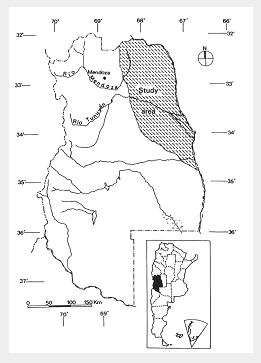
Figure 1. Relative position of the study area in Mendoza
Figura 1. Ubicación relativa del área de estudio
The area shows only a few scattered human settlements. Their main source of income is livestock breeding (mostly goats). In addition, people use the natural resources available to meet their basic needs, as is common in thinly populated semiarid regions (Nair, 1994).
The number of goats recorded for the department of Lavalle (northeastern Mendoza) was 75,000 in 1996 (Guevara et al., 1999), which represented 16% of the goats in Mendoza, managed primarily by small-scale farmers.
In these zones, where natural resources are limited, one of the inhabitants’ survival strategies is the diversified use of the various ecosystem components. Peasants ensure their basic income by using the different existing resources: goat herds, fauna, flora, fuelwood, etc. Handicrafts, and temporary jobs in nearby oases are additional sources of income. The use of a resource is necessarily based on an integrated production system, where every component participates in the total revenue. This use, whereby specialization gives way to diversification of the existing resources, is a common practice, as well as a genuine adaptive economic strategy, in arid environments. Thus, diversification and control over the entire production process are two key elements in rural organization (Regalsky, 1986).
Any policy designed to improve production systems should take into account the farmers’ knowledge about diversified resource use, and therefore, it should be validated and accepted by the community involved. Nevertheless, in the particular case of the drylands of Mendoza, there is little intervention of the local population in improving the forage supply, as a passive and extractive attitude still prevails.
The most relevant livestock activity in the northeastern plain of Mendoza is goat breeding, where the current productivity of livestock ranches is low. According to Guevara et al. (1991) disorderly livestock management and seasonal forage deficiencies are the major factors affecting productivity. The internal rate of return for a few models of livestock production efficiency has been evaluated by Piacentini et al. (1975) and Nahman (1986). Revenue from livestock production in arid lands is low (Guevara et al., 1981, 1985) on account of commercialization problems, lack of investment on infrastructure, and overgrazing, among other factors.
Recently implemented municipal programs have encouraged the community to participate in integrating goat breeding with tree nursery (plantules of forage species for multiple use) in order to reverse a strictly livestock-oriented view.
Prosopis species are relevant in dryland agroforestry systems. Prosopis flexuosa is a multiple-purpose tree: aside from being a source of timber, it is an efficient dune fixer, a provider of shade, fuelwood and fodder, a producer of honey, and a nitrogen fixer. Being scarce in arid lands, Prosopis forests require a special appraisal as system stabilizers, mainly by promoting non-extractive uses to prevent tree loss.
Current management
Currently, small-scale farmers make a multiple use of resources; however, this use is merely extractive. The major source of income is goat commercialization (Table 2), when the animals have reached a weight of 8-10 kg.
Table 2. Plant density and annual productivity per plant (kg DM) by the principal fodder species in the arid lands of Mendoza
Tabla 2. Densidad de plantas y productividad anual por planta (Kg/MS) de las principales especies forrajeras in la zona árida de Mendoza
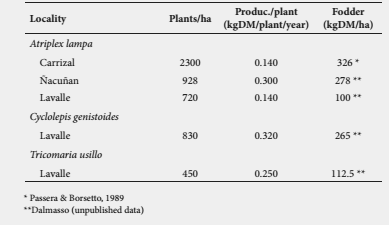
Livestock grazing is continuous, which results in both overuse of the areas next to watering places, and little use of the rest of the field. The overgrazing problem gets worse in communal lands, on which herds of different farmers exert constant pressure.
In the NE of Mendoza, the current mean forage biomass is 150 kg of dry matter per ha, dominated by shrubs, which represents a carrying capacity of 3.65 ha/animal unit. The carrying capacity assessed using the non-destructive modified Point Quadrat method (Passera et al., 1983) was 2.12 ha/animal unit at sites in good conditions, and 7.5 ha/animal unit at sites in poor conditions (saline areas).
The current management shows high kid mortality (40-45%) after parturition in the autumn-winter period (May-June), owing to inadequate infrastructure and malnourishment of mother goats. Enclosures protected from southern winds (strong and cold) are the solution to the first problem, while reserve paddocks would make up for fodder shortage. In the NE of Mendoza, the mean birth rate is 1.2 (120%), a value that includes double parturition and abortions. Smallscale farmers own flocks of around 150 goats of “criolla” race (partially crossbred with Anglo-Nubian). The traditional management consists only in gathering the animals every evening and driving them to the corral. The manure accumulated inside the corral is collected and commercialized.
Introducing deferred rotational grazing would be extremely difficult because of the communal use of plant resources, the scarce fodder supply, and the high infrastructure costs involved.
In arid lands, reserve paddocks are necessary. Areas of different size are fenced and enriched with native forage shrubs (high in protein), intended for livestock use in critical periods of forage shortage. The use of forage shrubs associated with trees is common in the arid regions of Australia (Leroy et al., 1995). In arid and semiarid lands shrubs play an important role since they maintain the foliage for a much longer time, ensuring nutrient availability for cattle during the critical winter period (Klusmann, 1988).
Considering the scarce information available on the management of natural resources and their extractive use in the arid northeast of Mendoza province, this paper proposes an agroforestry technique based on enrichment with native browse species, aimed at improving the traditional production systems used in the area. However, further long-term studies are necessary to confirm the results herein proposed.
Materials and Methods
Direct observation and polls conducted among small-scale farmers helped identify the most highly consumed species. Crude protein (N x 6.25) (Kjeldahl method, according to Müller, 1961), carbohydrates , acid detergent fiber (according to Van Soest & Wine, 1967), and nitrogen- free extract (AOAC, 1975) were determined for every species.
Plant density was estimated in a natural field (not enriched), by using 20x10 m plots, with 10 replications. Forage phytomass was evaluated through two cuttings (October and March), over a two-year period, with 10 replications. Cuts made in each species simulated the consumption intensities observed in the field.
Two pilot reserve paddocks, enriched with the browse species selected, were implemented in the study area. The proportion of plant association in the field was maintained; in addition, undesirable shrubs were replaced.
Results
Potential agroforestry interventions: Reserve paddocks in non-saline dunes and interdune areas
Reserve paddocks will allow stabilizing and reinforcing production through an improvement in the nutritional status of mother goats in critical periods, particularly during weaning.
Leading farmers are implementing pilot reserve paddocks, which are gaining growing acceptance. However, extensive use of this practice is still hard to achieve in the short term.
In environments of open forests of Prosopis flexuosa associated with Atriplex lampa and Capparis atamisquea (Photos 1 and 2), an agroforestry system is likely to be achieved, with a potential productivity of forage biomass of 489.5 kgDM/ha, for a total of 1,362 shrubs/ha.
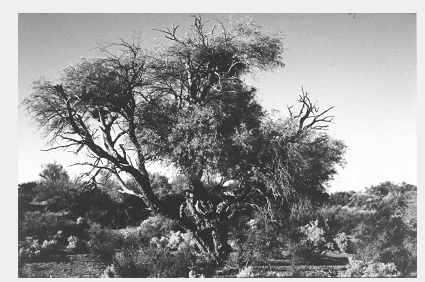
Photo 1. Open forest of Prosopis flexuosa enriched with Atriplex lampa
Foto 1. Bosque abierto de Prosopis flexuosa enriquecido con Atriplex lampa

Photo 2. Community of Prosopis flexuosa consociated with Cyclolepis genistoides and Capparis atamisquea
Foto 2. Comunidad de Prosopis flexuosa consociada con Cyclolepis genistoides y Capparis atamisquea
This productivity is reached by associating the following native forage species:
• Prosopis flexuosa (140 trees/ha) leaves and litter: 150 kgDM/ha (fruits are excluded since they are destined for other uses).
• Atriplex lampa: (720 shrubs/ha) 100.8 kgDM/ha
• Tricomaria usillo: (450 shrubs/ha) 112.5 kgDM/ha
• Lycium chilense: (110 shrubs/ ha) 13.2 kgDM/ ha
• Prospidastrum globosum: (82 shrubs/ ha) 13 kgDM/ ha
• Other species: 100 kgDM/ha (including the scanty herbaceous layer).
All of the above species show high productivity in nurseries, and survival after transplanting exceeds 70%. The proposed mixture of browse species requires selective clearing of non-forage species in the selected areas. Reserve paddocks, temporarily used, are part of a deferred grazing system.
Implementing reserve paddocks is unjustifiable in saline environments. C. genistoides prevails in these environments, with a natural density of 830 plants/ha that yield 266 kgDM of forage biomass. In these areas, a forage biomass of 320 kgDM/ha can be achieved by replacing undesirable species such as Plectrocarpa tetracantha, Suaeda divaricata, Allenrolfea vaginata with C. genistoides, until the latter species reaches a density of 1,000 plants/ha.
According to Cocimano et al. (1973), a goat eats 1.5 kgDM/day, which represents 547.5 kgDM/year. So the 489.5 kgDM/ ha/year estimated above would allow for a receptivity of 0.8 ha/animal unit; i.e. a threefold improvement with respect to the current management of sites in good conditions. Moreover, the use of reserve paddocks helps stabilize production without increasing the number of mother goats.
Reserve paddocks should be implemented in forage species-rich environments or in those likely to be enriched. Plant association should maintain maximum natural densities for each forage species used. The number of plant species to be introduced should not exceed 50% of the maximum natural densities.
Economically, the investment per hectare in a reserve paddock, including fencing and the purchase of 700 fodder plants, represents 100 kids. Usually the peasants and their families are responsible for producing their own plants and establishing the paddock.
Specific density was determined in the two most conspicuous environments (sandy and saline) in the eastern plain of Mendoza (Table 3).
Table 3. Plant density per hectare and forage biomass of the main forage shrub species
Tabla 3. Densidad de plantas por hectárea y forrajimasa de los principales arbustos forrajeros
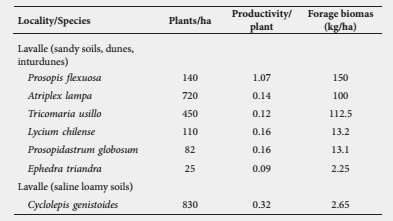
C. genistoides exhibits the highest productivity per plant, and prefers saline soils; T. usillo and A. lampa occur in sandy soils.
Table 4 shows the nutritional value of all six forage species used.
Table 4. Nutrient content of the different fodder shrub species of the arid zone of Mendoza
Tabla 4. Contenido nutricional de diferentes arbustos forrajeros de la zona árida de Mendoza

Overall, values are high, averaging 13.3 % of crude protein. Van den Bosch et al. (1997) report an average protein value of 11.4% for another five shrub species in the plains of Mendoza.
Comments on each shrub species suitable for reserve paddock enrichment in the NE of Mendoza
The most relevant forage species are: Atriplex lampa (Chenopodiaceae), Tricomaria usillo (Malphigiaceae), Ephedra triandra (Ephedracea), Prosopidastrum globosum (Leguminosae), Lycium chilense (Solanaceae) and, Cyclolepis genistoides (Compositae).
Atriplex lampa Gill.ex Moq (Chenopodiaceae)
Atriplex lampa is one of the most important forage plants in the study area. It is a perennial that blooms during September- October, and yields abundant fruit in November and December. The rest of the year it keeps its foliage, which can be exceptionally affected by frosts or pronounced droughts. As a fodder producer it has the advantage of having high protein contents, especially in the young shoots, ranging between 14.05% in summer and 19.75% in spring (Silva, 1987).
Its foliage concentrates salts, whether it grows in saline soils or not. Therefore, for its better use as fodder, it is convenient for the animals to have non-saline water available. When the water exceeds certain saline limits (3000 μSiemens/ cm conductivity) the animals can barely use this species. Reserve paddocks with A. Lampa are very sensitive to the action of fire, once burnt there is practically no recovery. Human intervention is required for its reestablishment.
It is an appropriate species for use in silvopastoral systems, associated with Prosopis in sandy soils. For another Atriplex species (A. repanda), Olivares& Gastó (1981) found an abrupt individual weight decrease associated with high plant density, and yet there was an increase in total productivity. In the case of reserve paddocks with Atriplex lampa, it is convenient to maintain the natural plant density. The fact that A. lampa shows high reproductive capacity in the nursery, and easy establishment in the field, indicates that enrichment with this species is advisable. In experiencing with active dune fixing, plant establishment by using plantules was 50% successful (Dalmasso et al., 1987), therefore in regular sandy soils better results are to be expected.
Thickets of A. lampa, usually poor in herbaceous species, are likely to occur even in places with annual precipitation lower than 150 mm.
At present this species is merely used for fodder in its natural status, with no enrichment techniques involved.
Cyclolepis genistoides Don. (Asteraceae)
This species is found preferably associated with Prosopis trees in different environments (Photo 2). It is a perennial species that has good fodder value (Table 4), and is much preferred by livestock. It is found in sandy and clayish soils with deficient drainage. Such soils are generally saline, with over 20,000 μSiemens/cm. In low interdune areas with more humid soils, this species proves a very important contribution to the fodder supply.
Fencing of these areas is advisable, so that they can be managed as reserve paddocks. Under nursery conditions it easily reproduces from seeds and responds well to transplanting.
This species is active in spring, summer, and autumm, though fructification is episodical according to water availability. Foliage is more abundant in summer and autumn. Estimated productivity of this species in its natural environment is 0.300 kg DM/plant. C. genistoides is dominant in plant communities of low specific diversity, accompanied by species from saline environments. On the other hand, at overgrazed sites, mature populations usually have very few new shoots.
Tricomaria usillo Gill. ex Hook. et Arn.
Tricomaria usillo is normally found in sandy soils or dunes. This perennial species, preferred by goats, is usually associated with Prosopis. Its reproduction is possible in nurseries through seed planting or, less effectively, through stake multiplication. This species acts as a soil fixer on account of the adventitious roots of its stems.
Foliation occurs after the spring and summer rains. It has a good diet value (Table 4). Its estimated productivity is 0.250 kgDM/plant.
Lycium chilense Miers ex Bert. var. chilense (Solanaceae)
Lycium chilense is a perennial species that has a rapid response to rainfall any time of the year. It is found in loamy and sandy soils. With non-saline water available it can bloom and fructify all year round. Rainfall occurrence during the period of vegetative recess stimulates rapid plant growth. This species is eaten by all types of livestock because of its good fodder value (Table 4).
Even though this species can be easily reproduced in nurseries, transplanting difficulties are due to its growing habits (prostrate) and poor biomass. It shows good response to transplanting. Its estimated productivity in a natural field is 0.120 kg DM/plant.
Ephedra triandra Tul. (Ephedraceae)
A perennial species that fructifies in spring, summer and autumm, depending on water availability. It abounds on swampy sites, with clay-loamy soils, generally associated with forests of Geoffroea decorticans (H. et A.) Burk., where it manifests its climbing habits. It is a palatable species, with high protein value (Table 4). Its estimated productivity is 0.090 kg DM/plant.
This species is important because it provides a useful fodder supplement in swampy areas where specific diversity is usually high. Reproduction success in nurseries is 50%.
Prosopidastrum globosum (Gill. ex Hook. et Arn.) Burk. (Fabaceae)
This is a perennial species that prefers dunes and sandy soils, and is palatable to goats. Its vegetative-reproductive activity concentrates in spring, summer and autumn, bearing fruit primarily at the end of spring and beginning of summer. It responds well to rainfall, though the leaves produced by the new shoots are not very persistent.
It is easily reproduced in nurseries. While being just a plantule, it is vulnerable to fungal disease. In the field transplanting success surpasses 60%. Enriching Prosopis forests with this species is recommended provided that soils are sandy. Its estimated productivity is 0.160 kg DM/plant.
Conclusions
In critical arid enviromments, like the north-east of Mendoza, the most adequate agroforestry technique is enrichment with native forage shrubs. Enrichment is practiced in open forests of Prosopis flexuosa, by associating the selected shrubs with these trees in all reserve paddocks. Compared with other sites in good condition, the carrying capacity in reserve paddocks can be tripled. This technique shows more favorable results when used in 5-10 ha areas. On the other hand, it results in increased number of marketable kids (2-3 months old), with no overgrazing of natural plant communities.
In critical periods (November-January), mother goats forage for supplementary protein-rich food in the reserve paddocks. Management involves twohour grazing a day, alternating natural range with the reserve paddock. From February through October the animals are kept out of the reserve paddocks to allow for shrub recovery.
Acknowledgments
We are grateful to J. C. Guevara, F. Roig (IADIZA), and H. L’ Houerou (CNR)† for their valuable comments. We thank N. Horak for the English version.
Bibliography
1. AOAC, 1975. Official of Analysis. (12thEdn). Washington, DC.: Association of Official Analytical Chemists. 1094 pp. [ Links ]
2. BERRA, A. & N. CIANCAGLINI, 1979. Mapas de evapotranspiración potencial de Mendoza. Cuaderno Técnico 1-79:1-128, IADIZA. [ Links ]
3. COCIMANO, M., A. LANGE & E. MENVIELLE, 1973. Equivalencias ganaderas para vacunos de carne y ovinos. Escalas simplificadas. Publicaciones Técnicas de AA-CREA, 23 pp. [ Links ]
4. DALMASSO, A.D., M. HORNO & R. CANDIA, 1987. Utilización de especies nativas en la fijación de médanos. En: Covas, G. (ed.), Erosión: Sistemas de producción, manejo y conservación del suelo y del agua (pp. 221- 290). Fundación Cargill. [ Links ]
5. ESTRELLA, H.A., V.A. HERAS & V. GUZZETTA, 1979. Registro de elementos climáticos en áreas críticas de la provincia de Mendoza. Cuaderno Técnico 1-79: 49-71. [ Links ]
6. GUEVARA, J.C., J.A. PÁEZ, R.F. TANQUILEVICH & O. ESTÉVEZ, 1981. Economía de las explotaciones ganaderas, I. Tierras privadas del área centro-este de la provincia de Mendoza. Cuaderno Técnico 4: 1-39. [ Links ]
7. GUEVARA, J.C., J.A. PÁEZ, R.F. TANQUILEVICH & O. ESTÉVEZ. 1985. Características económicas de las explotaciones ganaderas de El Sosneado, Mendoza. Rev. Arg. Prod. An. 5: 217-226. [ Links ]
8. GUEVARA, J.C., O. ESTÉVEZ, J.H. SILVA & A. MARCHI, 1991. Adequacy of native range grasses to meet protein and energy beef cow requirements in the plain of Mendoza, Argentina. Proceeding IVth International Rangeland Congress, Montpellier, France. [ Links ]
9. GUEVARA, J.C., O. ESTÉVEZ & C. STASI, 1999. Cost-benefit analysis of cactus fodder crops for goat production in Mendoza, Argentina. Small Rummiant Research 34: 41-48. [ Links ]
10. KLUSMANN, C., 1988. Trees and shrubs for animal production in Tropical and Subtropical areas. Plant Research and Development 27: 92-104. [ Links ]
11. LEROY, E.C., P.R. DANN, J.H. WILDIN, R.N. WESLEY-SMITH & A.A. MC. GOWAN, 1995. Trees and shrubs as sources of fodder in Australia. Agroforestry Systems 20 (1-2): 117-141. [ Links ]
12. MASOTTA, H.T. & A.B. BERRA, 1994. Relaciones suelo-paisaje en el campo experimental El Divisadero, Santa Rosa, Mendoza. Multequina 3: 89-97. [ Links ]
13. MÉNDEZ, E., E. MARTÍNEZ CARRETERO & C. WUILLOUD, 1993. La vegetación de las reservas naturales de la provincia de Mendoza III. La vegetación del campo experimental El Divisadero, Sta. Rosa. Parodiana 8(1): 113-123. [ Links ]
14. MÜLLER, L., 1961. Un aparato micro- Kjeldahl simple para análisis rutinarios rápidos de materiales vegetales. Turrialba 11: 17:25. [ Links ]
15. NAHMAN, E.S., 1986. Estudio de factibilidad de un proyecto de crédito de desarrollo para la ganadería bovina de Mendoza. Mendoza, Argentina: Dirección Agropecuaria. Serie Técnica Nº 31. 157 pp. [ Links ]
16. NAIR, P.K.R., 1994. Clasificación de sistemas agroforestales. In: Agroforestería. Centro de Agroforestería para el Desarrollo Sostenible. UACh, Mexico, 20 pp. [ Links ]
17. OLIVARES, E.A. & J. GASTÓ, 1981. Atriplex repanda. Organización y manejo de ecosistemas con arbustos forrajeros. Universidad de Chile. Fac. de Ciencias Agrarias, Veterinarias y Forestales. 300 pp. [ Links ]
18. PASSERA, C.B., A.D. DALMASSO& O. BORSETTO, 1983. Método de Point Quadrat Modificado. Informe del Taller sobre Arbustos Forrajeros de Zonas Aridas y Semiáridas, 7, 8 y 9 setiembre. FAO: 145- 152. [ Links ]
19. PIACENTINI, A.A., R.P. CHEZO & E.A. FERRARI, 1975. Diagramación y evaluación financiera de un establecimiento ganadero en la provincia de Mendoza. Mendoza, Argentina. Dirección Agropecuaria. Boletín Técnico 8. [ Links ]
20. REGALSKY, P.A., 1986. Panorama de la tecnología apropiada en Bolivia: lo Andino en el desarrollo tecnológico. Primer Congreso Nacional de Tecnología Apropiada. La Rioja, Septiembre 19-21, 1986. [ Links ]
21. ROIG, F., E. MARTÍNEZ CARRETERO& E. MÉNDEZ, 1988. Mapa ecológico de Mendoza. Atlas cartográfico de Mendoza, Diario Los Andes, Junio 1988. [ Links ]
22. ROIG, F., M. GONZÁLEZ LOYARTE, E. MARTÍNEZ CARRETERO, A. BERRA & C. WUILLOUD, 1992. La travesía de Guanacache, tierra forestal. Multequina 1: 83-91. [ Links ]
23. SILVA COLOMER, J., 1987. Evaluación de los recursos alimenticios de la zona árida del ámbito del Proyecto LUCDEME en ganado caprino. Tesis Doctoral, Univ. Córdoba, España. 229 pp. [ Links ]
24. TANQUILEVICH, R., 1971. Los suelos de la Reserva Ecológica de Ñacuñan. Deserta II: 131-206. [ Links ]
25. VAN DEN BOSCH, S., J.C. GUEVARA, F.M. TACCHINI & O. ESTEVEZ, 1997. Nutrient content of browse species in the arid rangeland of the Mendoza plain, Argentina. Journal of Arid Environments 37: 285-298. [ Links ]
26. VAN SOEST, P.J. & R.H. WINE, 1967. Use of detergent in the analysis of fibrous feeds. IV. Determination of plant cell-wall constituents. Journal of the Association of Official Analytical Chemists 50: 50-55. [ Links ]
Recibido: 03/2014
Aceptado: 09/2014














